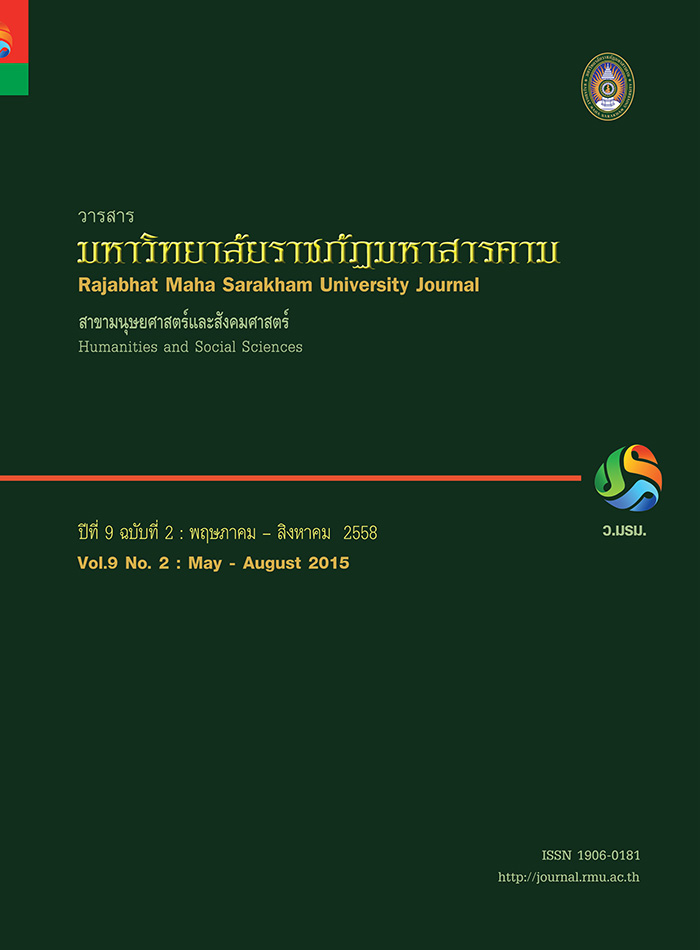ผลการเรียนด้วยโปรแกรมบทเรียนแบบผสมผสาน เรื่อง การใช้อินเทอร์เน็ต ที่มีต่อ ผลสัมฤทธิ์ทางการเรียน การคิดวิจารณญาณ และความคงทนในการเรียนรู้ ของนักเรียนประถมศึกษาปีที่ 4 ที่มีการนำตนเองในการเรียนรู้ต่างกัน;Effects of Learning with the Blended Learning Coursew
Main Article Content
Abstract
การวิจัยครั้งนี้มีจุดประสงค์เพื่อพัฒนาโปรแกรมบทเรียนแบบผสมผสานแบบ 50 : 50 เรื่องการใช้อินเทอร์เน็ตสำหรับนักเรียน
ชั้นประถมศึกษาปีที่ 4 ที่มีประสิทธิภาพ 80/80 และเพื่อประเมินผลการใช้โปรแกรมบทเรียนแบบผสมผสานที่พัฒนาขึ้น กลุ่มตัวอย่าง
เป็นนักเรียนชั้นประถมศึกษาปีที่ 4 โรงเรียนชุมชนบ้านสร้างแป้น ปีการศึกษา 2556 จำนวน 25 คน ได้มาโดยการสุ่มแบบกลุ่ม เครื่อง
มือที่ใช้ในการวิจัย ได้แก่ 1) โปรแกรมบทเรียนแบบผสมผสาน แบบ 50 : 50 ใช้สอน 8 สัปดาห์ เวลา 16 ชั่วโมง 2) แบบทดสอบผล
สัมฤทธิ์ทางการเรียน จำนวน 20 ข้อ 3) แบบวัดการคิดวิจารณญาณ จำนวน 30 ข้อ 4) แบบวัดการนำตนเองในการเรียนรู้ จำนวน 40
ข้อ และ 5) แบบวัดความพึงพอใจต่อการเรียนด้วยโปแกรมบทเรียนแบบผสมผสานที่พัฒนาขึ้น สถิติที่ใช้ในการทดสอบสมมุติฐานได้แก่
t-test และ F-test (One-way MANCOVA และ One-way ANCOVA) ผลการวิจัยพบว่า
โปรแกรมบทเรียนผสมผสานแบบ 50 : 50 ที่พัฒนาขึ้น มีประสิทธิภาพเท่ากับ 84.06/83.80 และมีดัชนีประสิทธิผลเท่ากับ 0.704
นักเรียนโดยรวม และจำแนกตามการนำตนเองในการเรียนรู้ มีผลสัมฤทธิ์ทางการเรียนและการคิดวิจารณญาณโดยรวมและเป็นรายด้าน
เพิ่มขึ้นจากก่อนเรียน (p<.001) นักเรียนที่มีการนำตนเองใน
การเรียนรู้สูงมีผลสัมฤทธิ์ทางการเรียนและการคิดวิจารณญาณโดยรวมและรายด้านทั้ง 3 ด้าน คือ ความสามารถในการพิจารณา
ความน่าเชื่อถือของแหล่งข้อมูลและการสังเกต ด้านความสามารถในการอุปนัย และด้านความสามารถในการนิรนัย มากกว่านักเรียน
ที่มีการนำตนเองในการเรียนรู้ตํ่า (p<.001) แต่นักเรียนทั้ง 2 กลุ่ม มีความคงทนในการเรียนรู้ไม่แตกต่างกัน และมีความพึงพอใจต่อ
การเรียนด้วยโปรแกรมบทเรียนแบบผสมผสานโดยรวม และรายข้อ อยู่ในระดับมากถึงมากที่สุด
This study aimed to develop the blended learning courseware 50:50 model entitled Internet Usage of
Prathomsuksa 4 Students with efficiency of 80:80 and to evaluate the developed blended learning courseware.
Twenty-five Prathomsuksa 4 students attending the Chumchon Bansang Pan School in the school year 2013
were selected as a sample group with the utilization of cluster random sampling technique. The research instruments
included (1) the blended learning courseware for 8 weeks of learning, 2 hours in a week; (2) an achievement test
with 20 items; (3) a critical thinking test with 30 items; (4) a questionnaire on self-directed learning with 40 items;
and (5) a questionnaire on satisfaction with learning through the developed blended learning courseware.
The statistics used for testing hypotheses were the T-test and the F-test (One-way MANCOVA and
ANCOVA). The findings revealed that the developed blended learning courseware had an efficiency of
84.06/83.80 and had an effectiveness index of 0.704.
The entire students as classified according to self-directed learning showed gains in individual and
overall results in the achievement and critical thinking tests before learning the developed blended courseware
(p<.001).
The students with high self-directed learning indicated high overall results in the achievement and
critical thinking tests and in 3 aspects which included: consideration of reliability of data resource and
observation, induction, and deduction compared to the students with low self-directed learning (p<.001).
On the other hand, the two sets of students did not indicate different learning retention after two weeks
of learning. They also showed an overall satisfaction with learning via the developed blended learning
courseware at the highest level.
Article Details
1. All articles undergo a thorough with at least three reviewers evaluating their suitability within the respective field of study, during the double-blind review.
2. The views expressed by individual authors do not represent the official views of the Editorial Boards of RMUJ: The author of each articie is responsible for all its contents.
3. The Editorial Boards do not reserve the copyrights. but proper citations need to be made.


